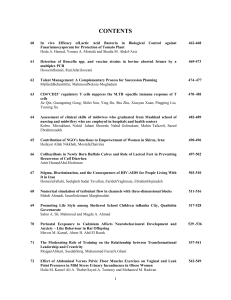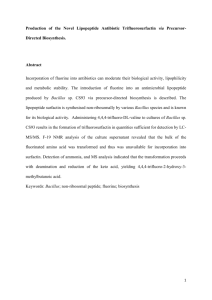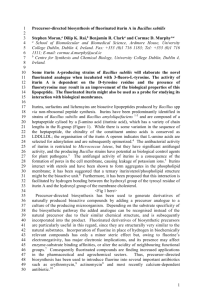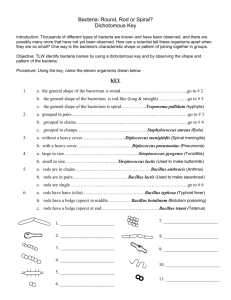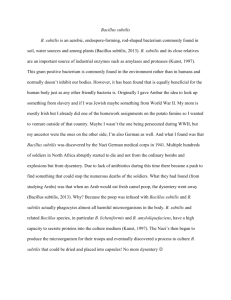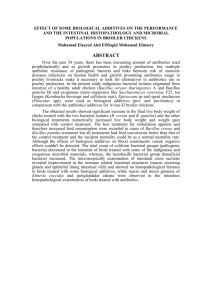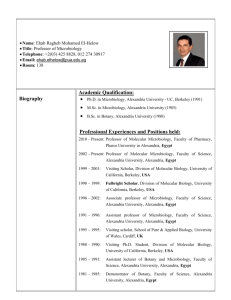Manuscript_revision_For_UCD_repository
advertisement
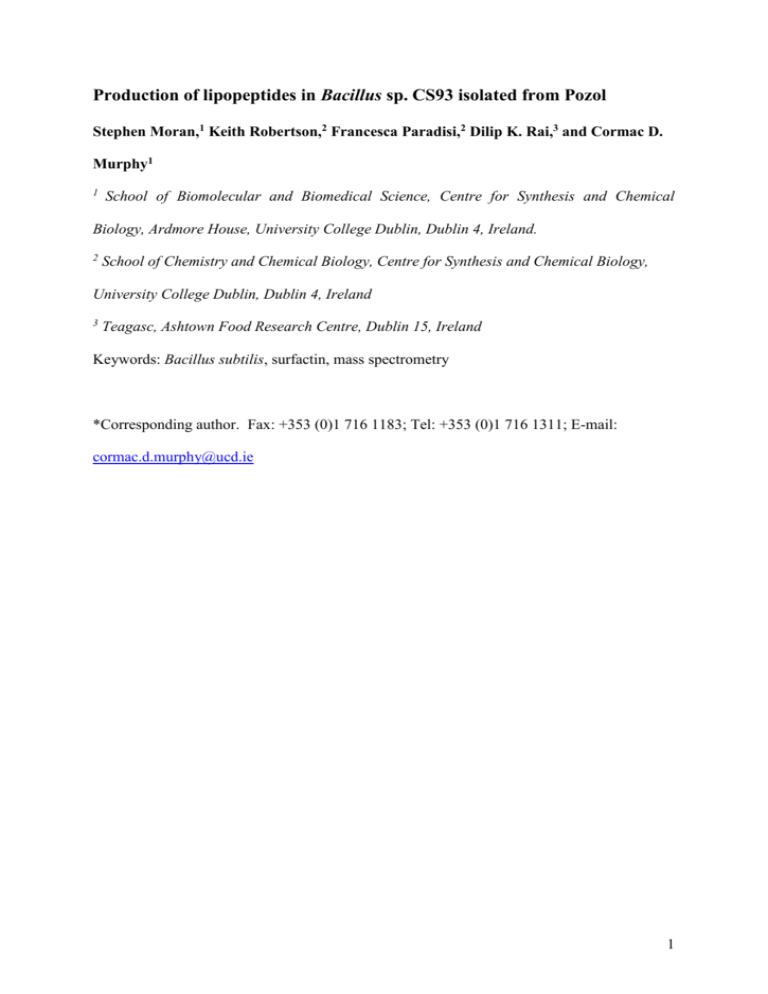
Production of lipopeptides in Bacillus sp. CS93 isolated from Pozol Stephen Moran,1 Keith Robertson,2 Francesca Paradisi,2 Dilip K. Rai,3 and Cormac D. Murphy1 1 School of Biomolecular and Biomedical Science, Centre for Synthesis and Chemical Biology, Ardmore House, University College Dublin, Dublin 4, Ireland. 2 School of Chemistry and Chemical Biology, Centre for Synthesis and Chemical Biology, University College Dublin, Dublin 4, Ireland 3 Teagasc, Ashtown Food Research Centre, Dublin 15, Ireland Keywords: Bacillus subtilis, surfactin, mass spectrometry *Corresponding author. Fax: +353 (0)1 716 1183; Tel: +353 (0)1 716 1311; E-mail: cormac.d.murphy@ucd.ie 1 Abstract Bacillus sp. strain CS93, which was previously isolated from Pozol, was shown to produce iturin A, bacilysin and chlorotetaine (T. G. Phister, D. J. O'Sullivan and L. L. McKay, Applied and Environmental Microbiology, 2004, 70, 631-634). To investigate the biosynthetic mechanism of chlorotetaine production, the bac genes were amplified from genomic DNA of Bacillus sp. CS93 by PCR, and sequenced. The genes bacABCDE were determined, but no gene that might code for a halogenating enzyme was detected either within the gene cluster, or in the flanking sequences. Following further analysis of culture supernatants that were active against bacteria by liquid chromatography-mass spectrometry (LC-MS), it was not possible to detect bacilysin/chlorotetaine. However, in methanolic fractions containing antibacterial activity molecular ions characteristic of surfactins and fengycin were detectable by ESMS. Using primers complementary for conserved regions of non-ribosomal peptide synthase, it was possible to amplify gene fragments that had a high degree of homology with known surfactin and fengycin biosynthetic genes. Thus in addition to the known antimicrobial compounds, we have shown that this strain produces other bioactive lipopeptides, which might account for some of the medicinal properties of Pozol. 2 Introduction Bacillus spp. produce a variety of membrane-active lipopeptides that are of pharmaceutical and agricultural interest, and include surfactins, fengycins, iturins (Bonmatin et al., 2003). These compounds occur as related isoforms that differ in some amino acid substitutions and length of the fatty acid side chains. Surfactins and iturins are composed of a heptapeptide linked to a -hydroxyfatty acid, whereas fengycin is a lipodecapeptide (Fig 1). These compounds have powerful antibacterial properties, which are a consequence of altering membrane integrity (Peypoux et al., 1999). Pozol is a non-alcoholic beverage from Southeast Mexico, made from lime-treated kernals of corn, which are ground, wrapped in banana leaves and allowed to ferment. The microbiology of Pozol has been studied, mainly focussing on the lactic acid bacteria involved in the fermentation (Diaz-Ruiz et al., 2003; Escalante et al., 2001). In addition to being consumed as food, the early Mayans used it as a treatment for intestinal complaints, diarrhoea and skin infections. Ray et al. (2000) isolated a bacterial strain from Pozol, which has antibacterial and antifungal activities, and probably contributes to its curative properties. The isolate’s physiological and biochemical characteristics indicated that it belongs to the Bacillus genus, and 16S rDNA sequencing revealed that it is most closely related to Bacillus subtilis 6633. Further investigation of the strain’s antibiotic properties revealed that it produces the antifungal lipopeptide iturin A, and the antibacterial compounds bacilysin and chlorotetaine (Phister et al., 2004). Recently, Moran et al. (2009) reported that fluorinated iturin A is produced when Bacillus sp. CS93 is incubated in the presence of fluorotyrosine. In this paper we describe the detection of other lipopeptides in culture supernatants of Bacillus sp. CS93 and the corresponding biosynthetic genes. 3 Methods Growth and maintenance of microbial strains Bacillus sp. CS93 (NRRL- β-21974) was obtained from Microbial Genomics and Bioprocessing Research Unit, National Center for Agricultural Utilization Research, 1815 N. University Street, Peoria, IL 61604, USA. Escherichia coli, Staphylococcus aureus and Saccharomyces cerevisiae were obtained from the culture collection of the School of Biomolecular and Biomedical Science, University College Dublin. The bacteria were maintained on tryptone soya agar slopes at 4 ºC; S. cerevisiae was maintained on yeast universal medium. E. coli XLI-Blue and E. coli DH5 were obtained from Stratagene, 11011 North Torrey Pines Rd., La Jolla, California, USA and were maintained as glycerol stocks (40 % v/v) at -80 ºC. Bacillus sp. CS93 was inoculated from an agar slope (TSA) into 50 ml Fred Waksman basic 77 supplemented with L-proline (1% w/v) and sodium nitrate (1% w/v) in 250 ml Erlenmeyer flasks and incubated at 30 or 37 º C and shaking at 200 rpm. To isolate the lipopeptide fraction, the supernatant was acidified to pH 3 with HCl, the insoluble material removed by centrifugation and extracted with methanol. Bioassay Antimicrobial activity of Bacillus sp. CS93 was assayed using either the agar well technique or the disc plate method, on TSA plates that were swabbed with a 24 h-old culture of the test strain. An aliquot (1 ml) of Bacillus sp CS93 culture was centrifuged and the supernatant lyophilised and resuspended in sterile water (100 µl), filtered and transferred to the agar well or paper disc. After 24 h incubation the zone of clearing was measured to assess the biological activity. Control experiments were conducted in which supernatant from Bacillus subtilis NCIMB 8565, which does not produce lipopeptide antibiotics when cultured under the same conditions, was assayed. 4 Polymerase chain reaction Bacillus genomic DNA was isolated according to the method of Kieser (2000). PCR reactions were conducted in a Biometra Tpersonal PCR thermocycler. FlexiTaq Polymerase (Promega) was used for amplification of both genomic and plasmid DNA templates in the appropriate supplied buffer. Each reaction contained dNTPs (deoxyribonucleotide triphosphates; 2.5 M each), MgCl2 (1.5 mM) and oligonucleotide primers (0.5-1 µM, MWG Biotech, Germany). Each reaction was made up to a final volume of 50 l using sterile deionised water. The primers used for the amplification of the bac gene cluster were BacFor (5’-GATCAACACGCTCGGT CCTGAAGG-3’) and BacRev (5’GGCCCTGAATCTGGTTCGCCGC-3’). For non-ribosomal peptide biosynthetic genes the degenerated primers were YTSFor (5’-TAY ACIWSIGGI ACIACIGG-3’) and LGG (5’AWIGARKSICCICCIRRSIMRAARAA-3’), where Y=C or T, W=A or T, S=G or C, R=A or G, K= G or T and M=A or C. Removal of excess dNTPs and oligonucleotide primers from PCR reactions was carried out using the Qiaquick PCR clean up kit (Qiagen). Ligation of the PCR product was achieved using the T-Easy vector kit (Promega). Ligation was carried out in a 10 μl reaction mixture containing 2x rapid ligation buffer (5 μl), pGEM®-T Easy Vector (1 μl), PCR product (3 μl) and T4 DNA ligase. The reaction mixture was incubated for 2 h at 22 °C. Chemically competent cells of E. coli were prepared using ice-cold calcium chloride as per the standard protocol outlined by Sambrook and Russell (2000) and stored on ice prior to use. E. coli XL1-Blue and E. coli DH5α were used for the propagation of recombinant plasmids. Competent cells (50 µl) were added to ligated plasmid DNA (10 µl). The suspension was chilled on ice for 30 min, then heat-shocked for approximately 90 s at 42 oC before being chilled on ice for 3 min. LB broth (200 µl) was added to the tube and the mixture was 5 incubated at 37 oC for 2 h to allow for expression of the ampicillin resistance gene. An aliquot (120 µl) of the reaction mixture was plated on a LB agar plate containing ampicillin (50 µg / ml) and incubated for 18 h at 37 oC. Small-scale isolation of plasmid DNA was achieved by use of the Qiaprep spin miniprep kit (Qiagen, Hamburg). DNA sequencing of plasmid DNA was carried out by MWG Biotech, Germany. LC-MS The LC-MS analysis was carried out as described previously (Moran et al., 2009). Briefly, a 20 l culture supernatant was injected onto an Atlantis T3, 3 µm C18 column (100 mm x 2.1 mm i.d.) using Waters Alliance 2695 HPLC system (Waters, Milford, MA, USA) interfaced to a mass spectrometer. Chromatographic separation of analyte was achieved in a 60% aqueous acetonitrile containing 0.1% formic acid. Electrospray mass spectra, in positive and negative ionisation mode, were acquired on a Quattro MicroTM mass spectrometer (Waters Corporation, Micromass MS Technologies, Manchester, UK). Mass Spectrometry Electrospray mass spectrometry (ESMS) and tandem mass spectrometry (MS/MS) experiments were performed on a quadrupole time-of-flight instrument (Q-Tof Premier, Waters Corporation, Micromass MS Technologies, Manchester, UK). Sample in 65% aqueous acetonitrile (1:1) was introduced to the mass spectrometer from a 250 µl gastight syringe at 8 µl/min. The ESMS data were recorded on a negative ionisation mode for m/z 100 to m/z 2000. The MS/MS data from the selected precursor ions (m/z 1034.7) were obtained for m/z 100 to m/z 1200. Collision energy of 18 eV was used to induce fragmentation of the precursor ions. 6 Results and discussion Sequencing of the bac gene cluster Our initial interest in Bacillus sp. CS93 was the biosynthesis of chlorotetaine, thus the strain was cultured using conditions similar to those previously described (Phister et al., 2004), and upon bioassay, visible zones of clearing were apparent on plates of E. coli (8 mm, well plate method), Staph. aureus (19 mm, disk plate method) and S. cerevisiae (17 mm, disk plate method). There were no zones of clearing in the control experiments. The LC-MS analysis of culture supernatant detected ions characteristics for iturin A (m/z 1043.5 and m/z 1057.6) (Moran, et al., 2009), which accounted for the anti-fungal activity and was consistent with the previous work with this strain. However, the ions expected for bacilysin (m/z 271.1) and chlorotetaine (m/z 289.1, plus an isotopic signal at m/z 291.1) were not observed, despite the culture supernatant exhibiting antibacterial activity. The absence of these secondary metabolites might be a result of very minor changes in culture conditions between this study and the previous work by Phister et al., since it is well established that small changes in culture conditions can have major impacts on the production of antibiotics (Bode et al., 2002), or the concentrations of these metabolites were too low in the crude supernatant to be detected by LC-MS. The bac gene cluster was amplified as described in the Methods section using primers designed from the bacA and bacE gene sequences of B. subtilis A1/3 and B. amyloliquefaciens ATCC15841. Since it is most likely that bacilysin is the immediate precursor of chlorotetaine, it was thought that the bac gene cluster in Bacillus sp. CS93 might contain a gene coding for a halogenase. The PCR experiment yielded a single band at 4.5 kb, which is the expected size of the cluster, when the annealing temperature was 65 C. The sequence of the amplicon was obtained by primer walking, starting with the original forward 7 and reverse primers, and subsequently using the ends of the sequenced strands to design new primers in order to obtain contiguous sequence data (Genbank accession number GQ889493). The sequence revealed the expected bacABCDE genes and showed 95 and 98 % homology with the bac genes from B. subtilis A1/3 and B. amyloliquefaciens, respectively. No gene that might code for a halogenating enzyme was present within the cluster. Flanking regions were also sequenced revealing a sequence coding for possible penicillin binding protein adjacent to bacA and a gene coding for an amino acid permease downstream from bacE, but no gene coding for a putative halogenase. Thus, Bacillus sp. CS93 has the necessary genes for bacilysin biosynthesis, but they did not seem to be expressed under the conditions that were used here. The mechanism of halogenation is still unclear, and if a halogenase is involved the corresponding gene is at a different locus on the chromosome. It is also possible that the appearance of chlorotetaine in the culture supernatant is a consequence of an abiotic reaction between chloride ions and bacilysin. Detection of other lipopetide antibiotics The presence of antibacterial activity in Bacillus sp. CS93 culture supernatants could not be accounted for by the production of iturin A (Peypoux et al., 1979) nor attributed to bacilysin/chlorotetaine, which suggested that the strain produced one or more other antibiotics that had not been identified in the original study (Phister et al., 2004). It was previously demonstrated that the activity in Bacillus sp. CS93 culture supernatants was inactivated in the presence of pronase E (Ray et al., 2000), indicating that other peptide antibiotics might be produced by the strain. Using a degenerated primer based on the LGG conserved region in subdomain A10 of non-ribosomal peptide synthases (Turgay & Marahiel, 1994) and a forward degenerated primer designed on the conserved region of the GTTG conserved sequence motif in core subdomain A3 (Fig 2), a 1.2 kb fragment was amplified 8 from Bacillus sp. CS93 genomic DNA. This was subsequently cloned into E. coli XLI-Blue; 25 positive clones were identified via blue/white screening, and of these 21 were shown to have the 1.2 kb insert after digestion of the plasmid with EcoR1. These were sequenced and homology searches revealed plasmid inserts YT 1-19 (GenBank accession number GU013559) had a 99 % deduced amino acid sequence identity with surfactin synthetase (SrfAA) from Bacillus amyloliquefaciens FZB42. Furthermore, plasmid inserts YT 20 and 21 (GenBank accession number GU013558) most closely matched the fengycin synthase (FenD) from the same species (99 % amino acid sequence identity). Therefore, culture supernatants of the bacterium were examined for the presence of a surfactin and fengycin, after acidification and extraction of the precipitate with methanol. ESMS analysis of the lipopeptide fraction (Fig 3 and Table 1) revealed the characteristic molecular ions for C12 to C15 surfactins (m/z 992.7, 1006.7, 1020.7 and 1034.7) (Koumoutsi et al., 2004; Chen et al., 2008), with leucine at position 7. The MS/MS data from the precursor ion m/z 1034.7 (Fig 4) revealed the loss of Leu-Leu-Asp residues (m/z 339.2) from the C-terminus generating a complimentary lipopeptide fragment (m/z 692.5). The loss of the -hydroxy fatty acid from the resulting lipopeptide chain was shown by the fragment ion m/z 452.3 (-Glu-Leu-Leu-Val), and a further loss of glutamate from the N-terminus was illustrated by the fragment ion m/z 323.2 (-Leu-Leu-Val-). Furthermore, ions with m/z that were indicative of C15 – C17 fengycins were also detectable (Fig 3 and Table 1) (Vater et al., 2002). It was also observed that the lipopeptides were not detected in the supernatants until after 3 days of growth at 37 °C, which would explain why the compounds were not detected by Phister et al. (2004), who harvested the cultures after 18-24 h incubation. Thus, in addition to iturin A, Bacillus sp. CS93 produces other lipopeptides that may account for the medicinal properties of Pozol. 9 Acknowledgement The authors acknowledge a UCD research demonstratorship (SM) and a studentship through the Programme for Research in Third Level Institutes (KR). References Bode HB, Bethe B, Hofs R & Zeeck A (2002) Big effects from small changes: Possible ways to explore nature's chemical diversity. Chembiochem 3: 619-627. Bonmatin JM, Laprevote O & Peypoux F (2003) Diversity among microbial cyclic lipopeptides: Iturins and surfactins. Activity-structure relationships to design new bioactive agents. Combinatorial Chemistry & High Throughput Screening 6: 541-556. Chen H, Wang L, Su CX, Gong GH, Wang P & Yu ZL (2008) Isolation and characterization of lipopeptide antibiotics produced by Bacillus subtilis. Letters in Applied Microbiology 47: 180-186. Diaz-Ruiz G, Guyot JP, Ruiz-Teran F, Morlon-Guyot J & Wacher C (2003) Microbial and physiological characterization of weakly amylolytic but fast-growing lactic acid bacteria: A functional role in supporting microbial diversity in pozol, a Mexican fermented maize beverage. Applied and Environmental Microbiology 69: 4367-4374. Escalante A, Wacher C & Farres A (2001) Lactic acid bacterial diversity in the traditional Mexican fermented dough pozol as determined by 16S rDNA sequence analysis. International Journal of Food Microbiology 64: 21-31. Kieser T, Bibb, M., Butter, M., Chater, K.F. and Hopwood, D.A. (2000) Practical Streptomycete Genetics. The John Innes Foundation, Norwich. Koumoutsi A, Chen XH, Henne A, et al. (2004) Structural and functional characterization of gene clusters directing nonribosomal synthesis of bioactive cyclic lipopeptides in Bacillus amyloliquefaciens strain FZB42. Journal of Bacteriology 186: 1084-1096. Moran S, Rai DK, Clark BR & Murphy CD (2009) Precursor-directed biosynthesis of fluorinated iturin A in Bacillus spp. Organic & Biomolecular Chemistry 7: 644-646. Peypoux F, Besson F, Michel G & Delcambe L (1979) Preparation and Antibacterial Activity Upon Micrococcus-Luteus of Derivatives of Iturin-a, Mycosubtilin and Bacillomycin-L, Antibiotics from Bacillus-Subtilis. Journal of Antibiotics 32: 136-140 Peypoux F, Bonmatin JM & Wallach J (1999) Recent trends in the biochemistry of surfactin. Applied Microbiology and Biotechnology 51: 553-563. Phister TG, O'Sullivan DJ & McKay LL (2004) Identification of bacilysin, chlorotetaine, and iturin A produced by Bacillus sp strain CS93 isolated from pozol, a Mexican fermented maize dough. Applied and Environmental Microbiology 70: 631-634. Ray P, Sanchez C, O'Sullivan DJ & McKay LL (2000) Classification of a bacterial isolate, from pozol, exhibiting antimicrobial activity against several gram-positive and gram-negative bacteria, yeasts, and moulds. Journal of Food Protection 63: 1123-1132. Turgay K & Marahiel MA (1994) A general approach for identifying and cloning peptide synthetase genes. Peptide Research 7: 238-241. Sambrook, J. & Russell, D. W. (2000) Molecular Cloning: A Laboratory Manual, New York, Cold Spring Harbour Laboratory Press. Vater J, Kablitz B, Wilde C, Franke P, Mehta N & Cameotra SS (2002) Matrix-assisted laser desorption ionization-time of flight mass spectrometry of lipopeptide biosurfactants in whole 10 cells and culture filtrates of Bacillus subtilis C-1 isolated from petroleum sludge. Applied and Environmental Microbiology 68: 6210-6219. 11 1 Table 1. Assignment of lipopeptides detected in culture supernatants of Bacillus sp. 2 CS93 by LC-MS ([M-H-]). 3 Mass peak (m/z) Assignment Amino acid at position 6/7 992.7 C12 surfactin Leu7 1006.7 C13 surfactin Leu7 1020.7 C14 surfactin Leu7 1028.6 * C13 surfactin + Na – 2H Leu7 1034.7 C15 surfactin Leu7 1042.7 * C14 surfactin + Na – 2H Leu7 1056.7 C15 surfactin + Na – 2H Leu7 1447.8 C15 fengycin Ala6 1461.8 C16 fengycin Ala6 1475.9 C17 fengycin Ala6 1489.9 C16 fengycin Val6 1503.9 C17 fengycin Val6 * Not labelled in Fig 3 4 12 5 Figure legends 6 Figure 1. Structures of the lipopeptides surfactin, iturin and fengycin 7 Figure 2. Peptide synthase adenylation domain showing the conserved regions and 8 subdomains A2-A10 (adapted from Turgay and Marahiel, 1994). 9 Figure 3. Electrospray MS analysis (negative ion) of the lipopeptide fraction from 10 Bacillus sp. CS93 11 Figure 4. Collision induced dissociation spectrum of ion m/z 1034.7 12 13 13 Figure 1. 14 15 14 16 Figure 2. 17 18 15 19 Figure 3. 20 21 16 22 Figure 4. 23 17


